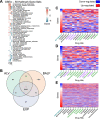Transcriptomics-based drug repositioning pipeline identifies therapeutic candidates for COVID-19
- PMID: 34112877
- PMCID: PMC8192542
- DOI: 10.1038/s41598-021-91625-1
Transcriptomics-based drug repositioning pipeline identifies therapeutic candidates for COVID-19
Abstract
The novel SARS-CoV-2 virus emerged in December 2019 and has few effective treatments. We applied a computational drug repositioning pipeline to SARS-CoV-2 differential gene expression signatures derived from publicly available data. We utilized three independent published studies to acquire or generate lists of differentially expressed genes between control and SARS-CoV-2-infected samples. Using a rank-based pattern matching strategy based on the Kolmogorov-Smirnov Statistic, the signatures were queried against drug profiles from Connectivity Map (CMap). We validated 16 of our top predicted hits in live SARS-CoV-2 antiviral assays in either Calu-3 or 293T-ACE2 cells. Validation experiments in human cell lines showed that 11 of the 16 compounds tested to date (including clofazimine, haloperidol and others) had measurable antiviral activity against SARS-CoV-2. These initial results are encouraging as we continue to work towards a further analysis of these predicted drugs as potential therapeutics for the treatment of COVID-19.
Conflict of interest statement
M.S. is on the advisory board of twoXAR. The García-Sastre Laboratory has received research support from Pfizer, Senhwa Biosciences and 7Hills Pharma. A.G.S. has consulting agreements for the following companies involving cash and/or stock: Vivaldi Biosciences, Contrafect, 7Hills Pharma, Avimex, Vaxalto, Accurius and Esperovax. Other authors declare no competing financial interests.
Figures





Update of
-
Transcriptomics-based drug repositioning pipeline identifies therapeutic candidates for COVID-19.Res Sq [Preprint]. 2021 Mar 30:rs.3.rs-333578. doi: 10.21203/rs.3.rs-333578/v1. Res Sq. 2021. Update in: Sci Rep. 2021 Jun 10;11(1):12310. doi: 10.1038/s41598-021-91625-1. PMID: 33821262 Free PMC article. Updated. Preprint.
Similar articles
-
Transcriptomics-based drug repositioning pipeline identifies therapeutic candidates for COVID-19.Res Sq [Preprint]. 2021 Mar 30:rs.3.rs-333578. doi: 10.21203/rs.3.rs-333578/v1. Res Sq. 2021. Update in: Sci Rep. 2021 Jun 10;11(1):12310. doi: 10.1038/s41598-021-91625-1. PMID: 33821262 Free PMC article. Updated. Preprint.
-
Identification of candidate repurposable drugs to combat COVID-19 using a signature-based approach.Sci Rep. 2021 Feb 24;11(1):4495. doi: 10.1038/s41598-021-84044-9. Sci Rep. 2021. PMID: 33627767 Free PMC article.
-
Drug repurposing screens identify chemical entities for the development of COVID-19 interventions.Nat Commun. 2021 Jun 3;12(1):3309. doi: 10.1038/s41467-021-23328-0. Nat Commun. 2021. PMID: 34083527 Free PMC article.
-
Knowing and combating the enemy: a brief review on SARS-CoV-2 and computational approaches applied to the discovery of drug candidates.Biosci Rep. 2021 Mar 26;41(3):BSR20202616. doi: 10.1042/BSR20202616. Biosci Rep. 2021. PMID: 33624754 Free PMC article. Review.
-
Clinically relevant cell culture models and their significance in isolation, pathogenesis, vaccine development, repurposing and screening of new drugs for SARS-CoV-2: a systematic review.Tissue Cell. 2021 Jun;70:101497. doi: 10.1016/j.tice.2021.101497. Epub 2021 Jan 26. Tissue Cell. 2021. PMID: 33550034 Free PMC article.
Cited by
-
Identifying therapeutic candidates for endometriosis through a transcriptomics-based drug repositioning approach.iScience. 2024 Mar 2;27(4):109388. doi: 10.1016/j.isci.2024.109388. eCollection 2024 Apr 19. iScience. 2024. PMID: 38510116 Free PMC article.
-
Integrative transcriptome-based drug repurposing in tuberculosis.bioRxiv [Preprint]. 2025 Jun 2:2025.06.02.657296. doi: 10.1101/2025.06.02.657296. bioRxiv. 2025. PMID: 40501823 Free PMC article. Preprint.
-
Drug Search and Design Considering Cell Specificity of Chemically Induced Gene Expression Profiles for Disease-Associated Tissues.Mol Inform. 2025 Jun;44(5-6):e2444. doi: 10.1002/minf.2444. Mol Inform. 2025. PMID: 40557969 Free PMC article.
-
Humoral immunogenicity assessment after receiving three types of SARS-CoV-2 vaccine.Sci Rep. 2023 Nov 18;13(1):20213. doi: 10.1038/s41598-023-47611-w. Sci Rep. 2023. PMID: 37980441 Free PMC article.
-
Endometriosis in the era of precision medicine and impact on sexual and reproductive health across the lifespan and in diverse populations.FASEB J. 2023 Sep;37(9):e23130. doi: 10.1096/fj.202300907. FASEB J. 2023. PMID: 37641572 Free PMC article. Review.
References
Publication types
MeSH terms
Substances
Grants and funding
LinkOut - more resources
Full Text Sources
Miscellaneous

